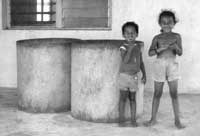
Shells from the obselete giant tariparau skin drums. They are said to have fallen out of use because obtaining a large enough shark skin to cover the drums required fishing beyond the reef with a hook from a human jawbone.
1. START
2. INTRODUCTION
3. MUSICAL CHARACTERISTICS
The musical charcteristics, form/structure, rhythm and cadences of an ura pa'u.
4. PERFORMANCE
Performaning the ura pa'u.
5. INSTRUMENTS
The instrumentation of an ura pa'u.
<<Previous | Page 1 2 3 4 5 | Next>>
INTRODUCTION
Since the arrival of the European explorers in 1823, the music and dance of Atiu, Mauke and Mitiaro has changed enormously. What has developed since that time, is a stylised musical tradition considered 'traditional' in all respects. The greatest losses have been the pe'e (chants), due to their progressively obsolete nature and function (in other words, the specific reasons for performing these chants is gradually being forgotten or replaced).
Three dance forms are found in Nga Pu Toru. The patoto (informal children's game dance), ura pa'u (drum dance), and kaparima (action song). The ura pa'u, or drum dance, perhaps the most well known genre, is accompanied by drums only: up to seven tokere in a range of size and pitch, a pa'u mango and a pa'u. It consists of contrasting rhythmic sections, some extremely fast, which show off the skills of the performer. A feature of ura pa'u is the addition of two or three beats to a phrase, which interrupt the otherwise stable metre. For kaparima accompaniment, the guitar and ukulele join the drums. This form also consists of several contrasting sections, and is a strictly metered setting of a secular text.
The dancers consist of two groups: the mapu (male and female youths) and the mamas (older women). There may be 12 - 30 dancers.
Accompanied by drummers (almost always male) on the pa'u (large double ended skin drum), pa'u mango (free standing single headed drum), and several ove/pate (a slit drum). Numbers vary according to the occasion. (Seven drummers is average).
It is thought that the ura pa'u closely resembles the dances of ancient times, as described in the early literature.
What event has led to the loss off the pe'e from the Cook Island culture?
What name is given to the children's game dance?
What instruments would you expect to hear in a kaparima?
© jeni little | chimaera 2010 | rights reserved